The H.J. Andrews Experimental Forest, located in the Willamette National Forest on the western slope of the Cascade Range, is one of 84 experimental forests in a network established by the U.S. Forest Service. It is one of the most well-studied forests in the world, famous for the long-term ecological research that has been conducted there since it was established in 1948. I had the opportunity to experience and explore this extraordinary place in October 2019, thanks to the Spring Creek Project for Ideas, Nature, and the Written Word, a collaboration between the Forest Service and Oregon State University. To explain how I came to be at “the Andrews” – as everyone who knows it calls it – takes, well… some explaining.
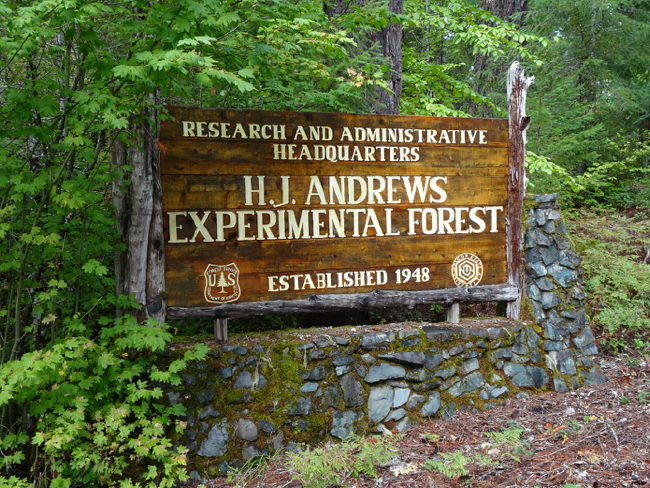
The first thing to know is that interdisciplinary long-term ecological research has been a core mission of the Andrews Experimental Forest from its inception, and also that there has always been a close relationship between the U.S. Forest Service and Oregon State University in that research. The second is that in 2002, some Oregon State faculty members from departments other than the sciences (such as philosophy and liberal arts) started an initiative with forest scientists called “Long-Term Ecological Reflections,” with the aim of bringing the arts and humanities into the “interdisciplinary” mix at the Andrews. That creative collaboration between writers, artists, and scientists is now managed by The Spring Creek Project.
I’d been aware of the Andrews-Spring Creek collaboration for a few years, but I only began to get acquainted with some of its instigators last year, when I was the Howard L. McKee Ecology Resident at the Sitka Center for Art and Ecology, at Cascade Head on the Oregon Coast. Those connections led to an invitation to spend the first half of October of this year at the Andrews Experimental Forest. Wow, I thought, that sounds wonderful… And then I wondered: What do I have to do there to deserve that opportunity? I came to understand that all I had to promise was to a write a creative “reflection” for “The Forest Log,” the arts-and-humanities counterpart of the extensive database of scientific studies at the Andrews. I accepted the invitation, and went. My main point-of-contact was Dr. Fred Swanson, a retired U.S. Forest Service scientist who started his career in the Andrews in 1972. Fred is now a senior fellow with the Spring Creek Project, and he gave me an orientation on my second day in the Forest. Among other places, he showed me the three “Reflections” sites that writers and artists are encouraged to visit for inspiration: a gravel bar along Lookout Creek near the Andrews Headquarters, the Log Decomposition Study site, and the Blue River Face Timber Sale site. Each of these sites has an underlying record of scientific observations.
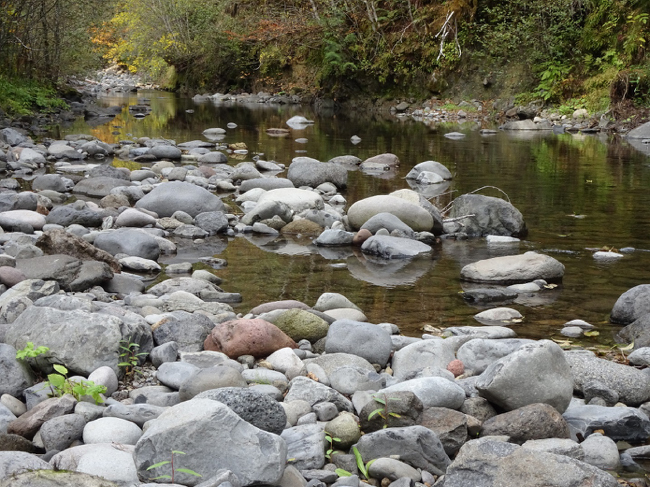
I was assigned a spacious, spare, comfortable apartment at the headquarters “campus.” I was given a master key to all the locked gates on all the roads in the Forest, and an official Forest Service radio – a heavy, black, brick-like thing – with which I could listen to the daily weather updates, the chatter of other Andrews scientists and managers, and call in for a rescue in case of emergency (if my car went into a ditch on a back road, if I slipped and broke my leg on a remote trail, or if I got lost wandering in an old-growth watershed). I felt like a kid, officially let loose: “Go out and play, and if you get in trouble, call the Frissell Ridge repeater on your radio!” So, I did go out and play in the amazing forest landscape of the Andrews – and never had to call for a rescue. October is when the transition from dry to wet typically happens in Oregon’s strongly seasonal climate; this year, the majority of my days were glorious. This was my idea of heaven.
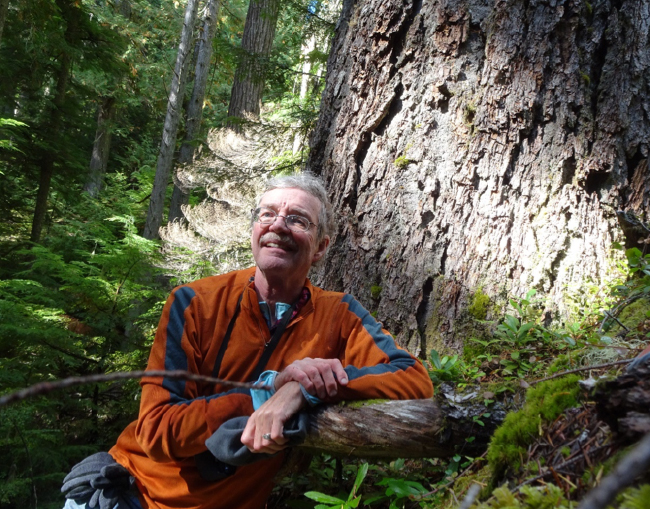
At first called the Blue River Experimental Forest when established in 1948, it was renamed for Horace J. Andrews in 1953, after his untimely death in a car accident, because of his instrumental role in the selection of the site and establishment of the research there. Andrews and his colleagues were interested not only in the value of wood that could be harvested from Pacific Northwest forests, but also other forest-dependent values that were barely coming to be recognized, especially water in watersheds and habitat for fish. At that time, the relationships between forests, water, and what is now called “biodiversity” were not well known, and the burgeoning timber industry really didn’t want to know anything that might slow down their program to cut all of what they called “decadent” old-growth forests and replace them with “efficient” two-by-four-producing tree monocultures.
The site chosen for the experimental forest was the entire 16,000-acre watershed of Lookout Creek, whose water joins the Blue River, a tributary of the McKenzie River; the McKenzie flows westward from the Cascades into the Willamette River near Eugene, Oregon.
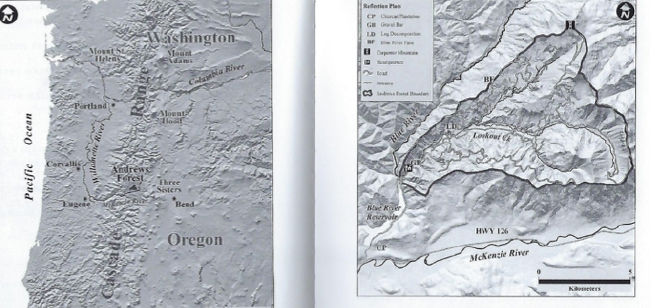
The common phrase “can’t see the forest for the trees” refers to a situation in which a holistic, “big picture” view (in time or space) is blocked because of giving too much attention and weight to details in the foreground. I also think of it as referring to reductionistic sciences, which atomize observations and silo knowledge – in contrast to holistic sciences, like ecology, that synthesize and integrate observations to seek the big picture, the “whole” that is more than the sum of the parts. Research at the Andrews Experimental Forest has been guided by an integrative, interdisciplinary vision from the beginning. Andrews managers and scientists were interested in understanding the full range of forest benefits and values, and recognized that would require understanding how forests function ecologically – “seeing the forest,” not just looking at the trees.
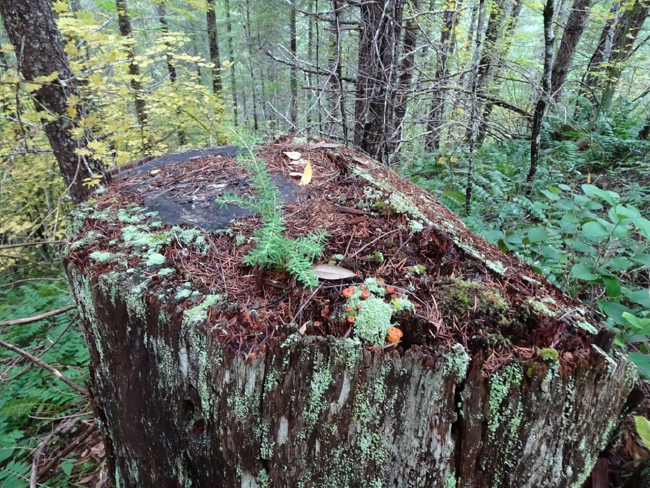
To begin to learn how these forests function, curious forest scientists working in the Andrews initially selected three small watersheds that drained old-growth forest about 500 years old, each of which flowed into Lookout Creek. Stream gauging began in these first three watersheds in 1952. After gathering baseline data, experimental treatments began in Watershed #1 in 1962; it was 100% clearcut, but using a cable logging system, new for its day, that required no road building, and it was deliberately burned in 1967. In Watershed #3, roads were constructed in 1959, and in 1963, 25% of the forest was clearcut in patches. Watershed #2, between these two drainages, was left untouched, providing an undisturbed, old-growth experimental control for the forest management experiments in the two adjacent watersheds. Maybe you can appreciate that this was unique, large-scale, long-term, applied forest ecology research – which is what has made the Andrews world-famous. Over the next three decades, five more small watersheds, and one larger one, Mack Creek, were brought into the research program.
A big boost for that research began in 1968, when the Andrews was chosen to participate in the International Biological Program (IBP), with funding from the National Science Foundation (NSF). The IBP was a ten-year program of international cooperation, modelled on the success of the International Geophysical Year of 1957-58, to better understand the functioning of ecosystems at large scales. In the U.S., where interdisciplinary studies at sites in five “biomes” – grassland, tundra, desert, deciduous forests, and coniferous forests – were carried out, the IBP helped to establish a new approach, now known as “landscape ecology,” which seeks to understand the history of the dynamic forces that pattern ecosystems at relatively large spatial scales. The Andrews Forest was one of two “coniferous forest biome” sites in the Pacific Northwest, with a second in Washington.
Building on the IBP landscape ecology studies, in 1976 the Andrews Experimental Forest was designated a biosphere reserve in the United Nations Education, Scientific and Cultural Organization’s (UNESCO) Man and the Biosphere Program (MAB). Like its older but less famous “sister” experimental forest, the Cascade Head Experimental Forest, the Andrews was among the first group of 27 biosphere reserves in the U.S., hand-picked by a team of scientists led by Dr. Jerry Franklin. Jerry knew both the Andrews and Cascade Head very well from his work in both places. For a number of understandable and valid reasons, the Andrews Forest dropped out of the UNESCO-MAB program in 2017, along with 16 other U.S. biosphere reserves that decided not to engage in the time-consuming periodic review process required by the international program. To their great credit (in my opinion), the U.S. Forest Service’s Siuslaw National Forest, administrative managers of the Cascade Head Biosphere Reserve, did make the effort to conduct a periodic review, and Cascade Head remains in the MAB program. But the UNESCO-MAB plaque still stands in front of the Andrews Headquarters, and it is my hope that the Andrews will actively rejoin the program at some future date.
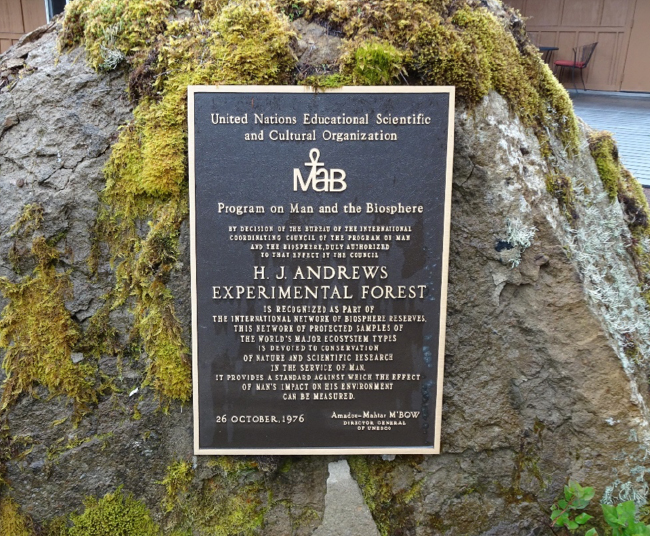
In 1980, the NSF-supported Long-Term Ecological Research (LTER) program began to fund research at the Andrews, and that funding has continued to the present time. It has supported a wide range of interdisciplinary studies of forest ecology through many careers, and decades of dedication by an interdisciplinary team of forest scientists. By the early 1990s, research at the Andrews had become a fulcrum for the Northwest Forest Plan, a radical reorientation of forest management in the Pacific Northwest. Jerry Franklin was one of the scientists who drafted the plan, which was approved by President Clinton in 1994.
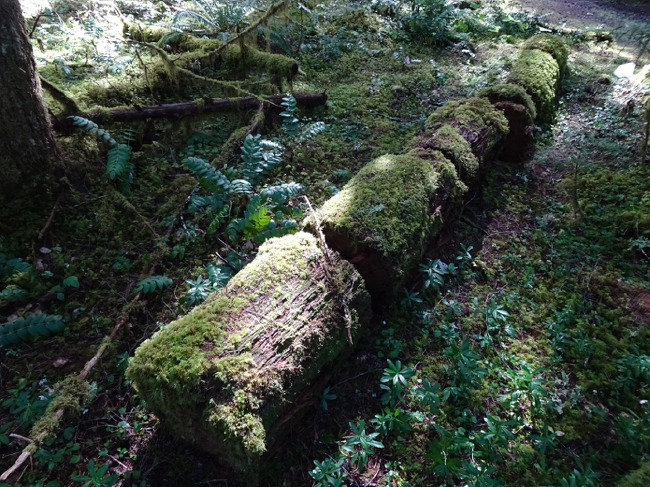
Several thorough and scholarly histories of the Andrews Experimental Forest have been written, the most recent of which (2018) is “The H.J. Andrews Experimental Forest: Seventy Years of Pathbreaking Forest Research,” by William Robbins, in the Oregon Historical Quarterly. John Luoma’s solid non-fiction “biography” of the Andrews Forest, The Hidden Forest: The Biography of an Ecosystem (Oregon State University Press), told its story up to 1999. In his 2018 novel, The Overstory, Richard Powers changed a few names of people and places, but clearly referred to the Andrews Forest. He calls it the “Franklin Experimental Forest,” an insider nod to Jerry Franklin and his legacy. The Overstory won the 2019 Pulitzer Prize for Fiction and received many praiseful reviews (for me – a bear of very little brain, I guess – I find it highly “overstoried”). Forest Under Story is a collection of writings from the first twelve years of the Long-Term Ecological Reflections program, published by the University of Washington Press in 2018. It contains a delightful mix of styles and voices, all stimulated by this special place.
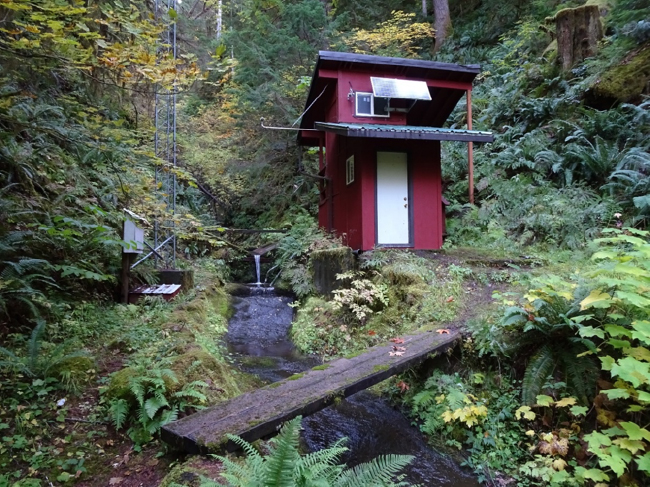
During my research last year as the Sitka Center Ecology Resident, I had become especially interested in the results and implications of the almost 70-year history of forest hydrology research at the Andrews – that is, how forests interact with rainfall, soils, and streams. A summary of that research, reported in a paper by Timothy Perry and Julia Jones in 2016 in the journal Ecohydrology, was titled: “Summer streamflow deficits from regenerating Douglas-fir forest in the Pacific Northwest, USA.” That might not sound provocative, but the first few sentences of the abstract pack a carefully-worded scientific punch with important implications. These scientists admit that the effects of forest management practices – namely clearcutting and replanting as forest plantations – needs more research. However, they then confirm that research clearly shows a dramatic impact of clearcutting and tree plantations on streamflow: a reduction in water flows at the end of the dry summer season of up to 50 percent that lasts for decades. Their conclusions ramify far beyond the Andrews, and suggest that because of the logging history of the region, most watersheds in the Pacific Northwest are probably experiencing significant, but previously unrecognized, summer streamflow deficits compared to pre-logging conditions. Because the hydrological effects are caused by the physiology of young forests, it doesn’t appear likely that changes in industrial forestry practices can reduce their harmful effect on stream flows. The only solution would seem to be reducing the area of forestry plantations and letting larger areas return to mature and old-growth forest conditions.
Perry and Jones pointed out another implication of their ecohydrological research: “Reduced summer streamflow has potentially significant effects on aquatic ecosystems. Summer streamflow deficits in headwater basins may be particularly detrimental to anadromous fish, including steelhead and salmon, by limiting habitat [and] exacerbating stream temperature warming.” So, because summer streamflow deficits may threaten fish like coastal Coho salmon that are listed under the Endangered Species Act, plantation forestry practices may in turn exacerbate complex and contentious tradeoffs between in-stream flows mandated to protect fish, and human water uses, such as for drinking water and irrigation. If you are thinking that this science sounds politically sensitive in a state like Oregon… that’s an understatement!
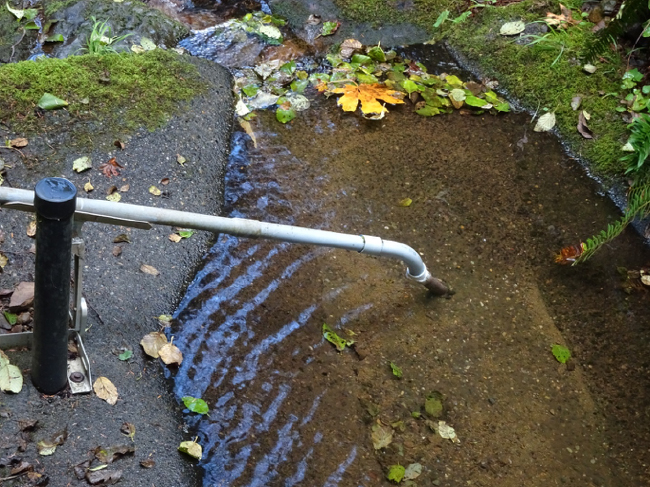
Because of all this, when I had the chance, I made it a goal to visit all of the stream guaging stations and walk in all eight of the experimental and control watersheds in the Andrews that had been the basis for the Perry and Jones research. I even had the chance to visit a few of those watersheds with Dr. Julia Jones herself, and talk about the science and the policy controversy created by her research. And I spent a morning in the field with Dr. Sherri Johnson, whose title is Supervisory Research Ecologist with the USFS Pacific Northwest Research Station. Sherri emphasized that there are still many unanswered questions about forests, water, and endangered Pacific salmon, and cautioned about over-extrapolating the research from the Andrews to other places (such as watersheds west of the Oregon Coast Range) and to larger scales.
I will have to leave more detailed descriptions of my encounters with fellow residents of the Andrews for a later time: with rough-skinned newts, lobster mushrooms, barred owls, vine maple, devil’s club, and many others. And my impressions of the sophisticated technology of forest research, hikes up Lookout Mountain, and more.
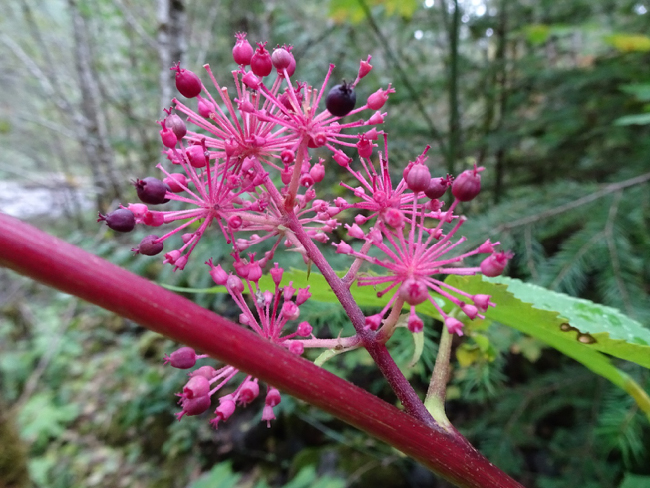
My residencies at both the Andrews Forest with the Spring Creek Project and at Cascade Head with the Sitka Center for Art and Ecology have given me the chance to compare these different models of how to bridge the gap between the sciences and the arts and humanities, which have been described, in the past, as the “two cultures.” British chemist and novelist C.P. Snow made the phrase famous through a lecture and subsequent book, The Two Cultures and the Scientific Revolution, both from 1959, in which he lamented what he saw as a fundamental split in western intellectual life, and which he said was hindering solutions to urgent problems. Many people then thought of science and humanities and art as very different ways of experiencing and knowing the world – and some still may. They imagine that there is a gulf between science and the arts, or even that they are “opposites.” I have tried hard to understand this purported cultural schizophrenia, which I have never felt.
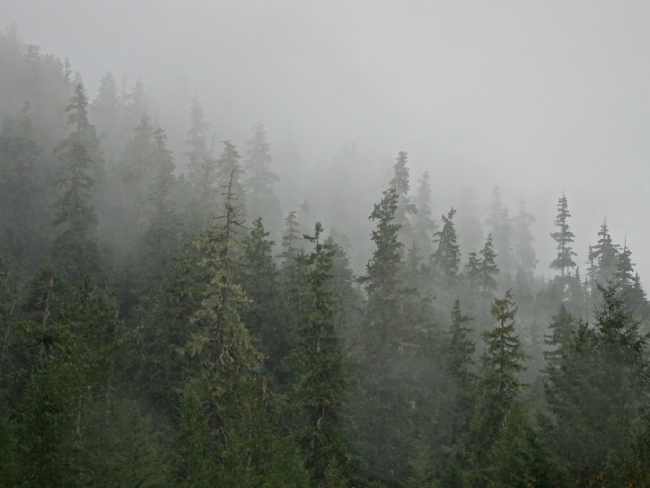
The Spring Creek Project says that the “mission of the Long-Term Ecological Reflections program is to bring together writers, humanists, and scientists to create a living, growing record of how we understand the forest and the relation of people to the forest, as that understanding and that forest both change over time.” The website says that, for Andrews writing residencies, they are looking for “creative writers whose work reflects a keen awareness of the natural world and an appreciation for both scientific and literary ways of knowing.” The Sitka Center says that “the mission of the Howard L. McKee Ecology Residency is to provide space and time for transformative ecological thought. … Ecology residents at Sitka live in a small community alongside an exceptional group of musicians, visual artists and writers who are thinkers, philosophers, and change agents. This environment fosters interdisciplinary dialogue, cross pollination, and the opportunity to approach problems and questions with a fresh perspective.”
These approaches to the “two cultures” problem sound somewhat similar, although they evolved from distinctly different “ancestors.” As described above, the foundation at the Andrews is long-term forest research. At the Sitka Center (founded in the early 1970s), the arts have always been the forte, despite the term “ecology” in the organization’s name. The Sitka website lists around two dozen ecologists who have been residents over the years, alongside several hundred artists, writers, and musicians. Some prominent ecologists have been residents at Sitka, including Jerry Franklin, who told me that he finished conceptualizing his recent textbook, Ecological Forest Management (published in 2018), when he was a resident in 2015. The ecology-dedicated McKee Ecology Residency at Sitka has only become formalized in the past few years. With these different historical trajectories, but somewhat overlapping ambitions, the two programs could clearly learn from each other.
In some ways, programs that encourage dialogues between “scientists” and “artists” may help to perpetuate the view that these are two different ways of experiencing the world. But some of our most influential ecological thinkers over the past two centuries have been individuals who themselves, in their own work, writing, and art, bridged the gap. I’m thinking of Henry Thoreau, Thomas Cole, John Muir, Edward Ricketts, Aldo Leopold, and Rachel Carson, among others. The Andrews Long-Term Ecological Reflections Program and the Sitka Center Ecology Residency could be platforms for elevating new voices that continue this important American tradition of rejecting the two-cultures worldview.
For related stories see:
- Report from a Season at Cascade Head, February 2019
- The Art of Ecology: Audubon’s Oystercatchers and Other Examples, November 2014
- The Art of Ecology: A Pilgrimage to the Heart of the Andes, February 2015
- The Art of Ecology: Sketching with Cole and Church, May 2015
- In Search of the Sublime with Albert Bierstadt in Colorado, July 2015
- In Search of the Sublime with Albert Bierstadt in Brooklyn, February 2016
- Another Conversation with Thomas Cole, February 2018
- Winter Walk with Audubon in Upper Manhattan, February 2018
Sources and related links:
- Arts and Humanities at the Andrews Experimental Forest
- Spring Creek Project for Ideas, Nature, and the Written Word. Oregon State University, College of Liberal Arts.
- The Forest Log
- Andrews Forest “Reflections” Plots
- H.J. Andrews Experimental Forest Map
- Lookout Creek Old Growth Trail Brochure
- H.J. Andrews Experimental Forest History
- Robbins, William G. 2018. The H.J. Andrews Experimental Forest: Seventy Years of Pathbreaking Forest Research. Oregon Historical Quarterly. 119(4): 454-485.
- Duncan, Sally. 1999. Openings in the forest: the Andrews story. In: Forest History Today. Durham, NC: Forest History Society; Fall: 20-28.
- Luoma, Jon R. 2006. The Hidden Forest: The Biography of an Ecosystem. Oregon State University Press.
- Forest Under Story: Creative Inquiry in an Old-Growth Forest. 2018. Edited by Nathaniel Brodie, Charles Goodrich, Frederick J. Swanson. U. of Washington Press, Seattle.
- Powers, Richard. 2018.The Overstory: A Novel. W.W. Norton & Company, New York.
- Perry, Timothy D., and Julia A. Jones. 2016. Summer streamflow deficits from regenerating Douglas‐fir forest in the Pacific Northwest, USA. Ecohydrology, Special Issue Paper.
- Frissell, Christopher A. 2017. Implications of Perry and Jones (2016) study of streamflow depletion caused by logging for water resources and forest management in the Pacific Northwest.
- Howard L. McKee Ecology Residency, Sitka Center for Art and Ecology
- Franklin, Jerry F., K. Norman Johnson, and Debora L. Johnson. 2018. Ecological Forest Management. Waveland Press, Inc., Long Grove, IL.

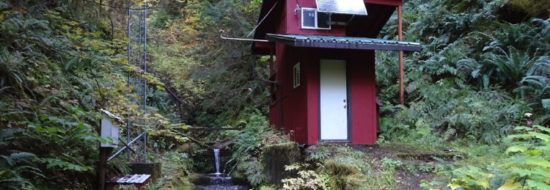



December 20, 2019 3:27 pm
Interesting, informative, and moving…as usual. All the best for the New Year.
dave armstrong
Resident Naturalist
Sylvan Dale Guest Ranch
December 27, 2019 10:26 pm
A lovely, insightful essay, thank you! Hopefully we will see you in Oregon again soon. Caldera residency? PLAYA? So many to keep you coming here.